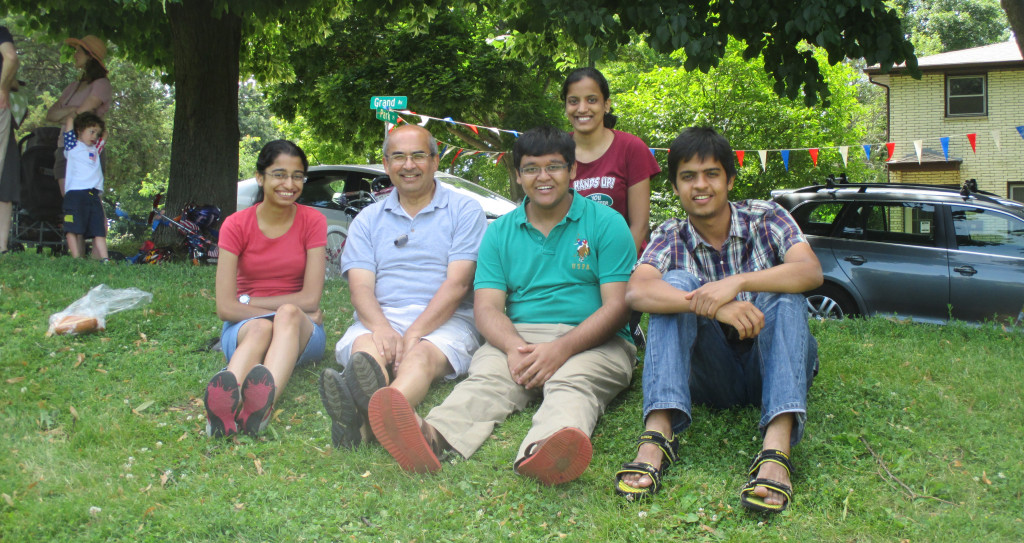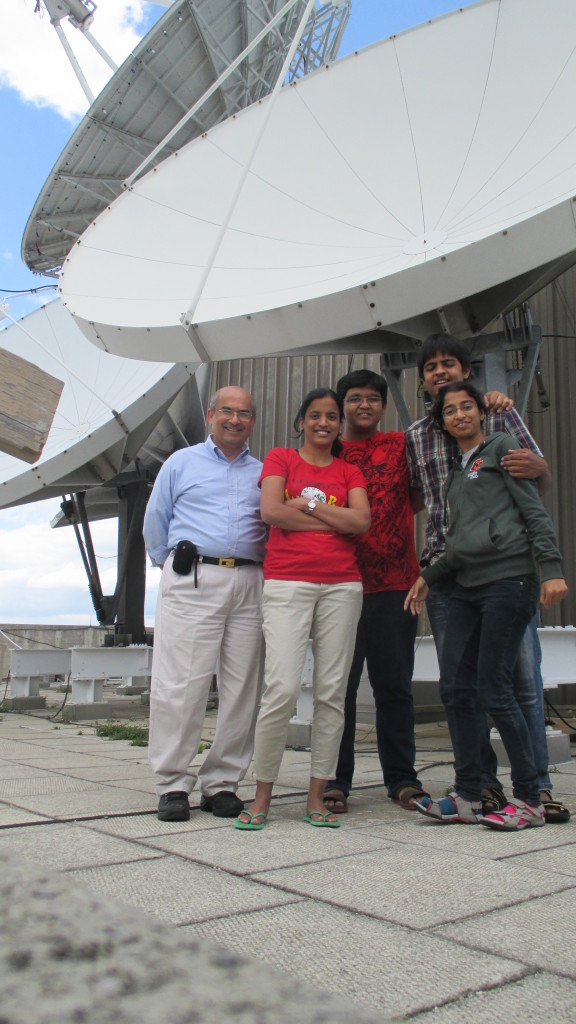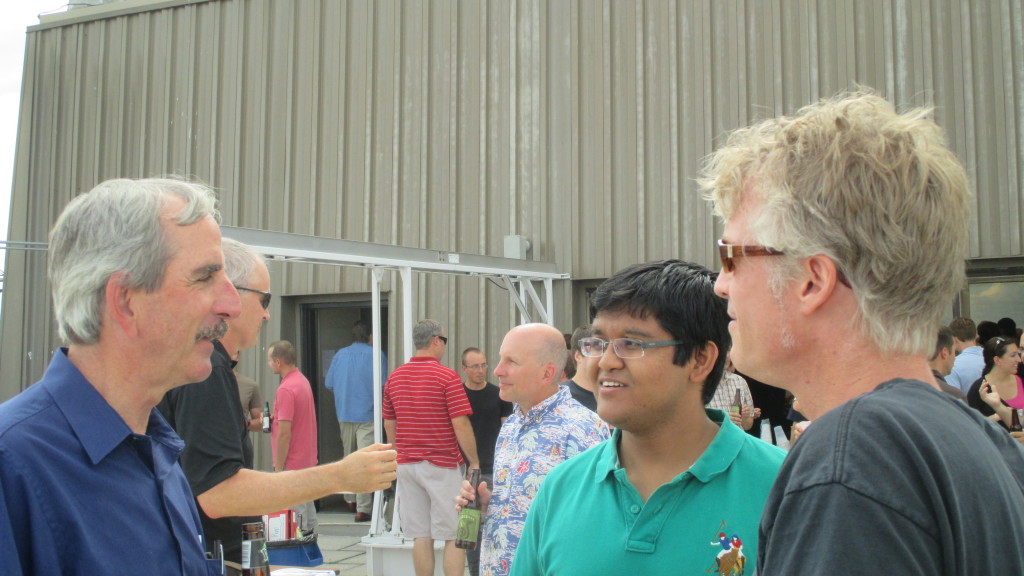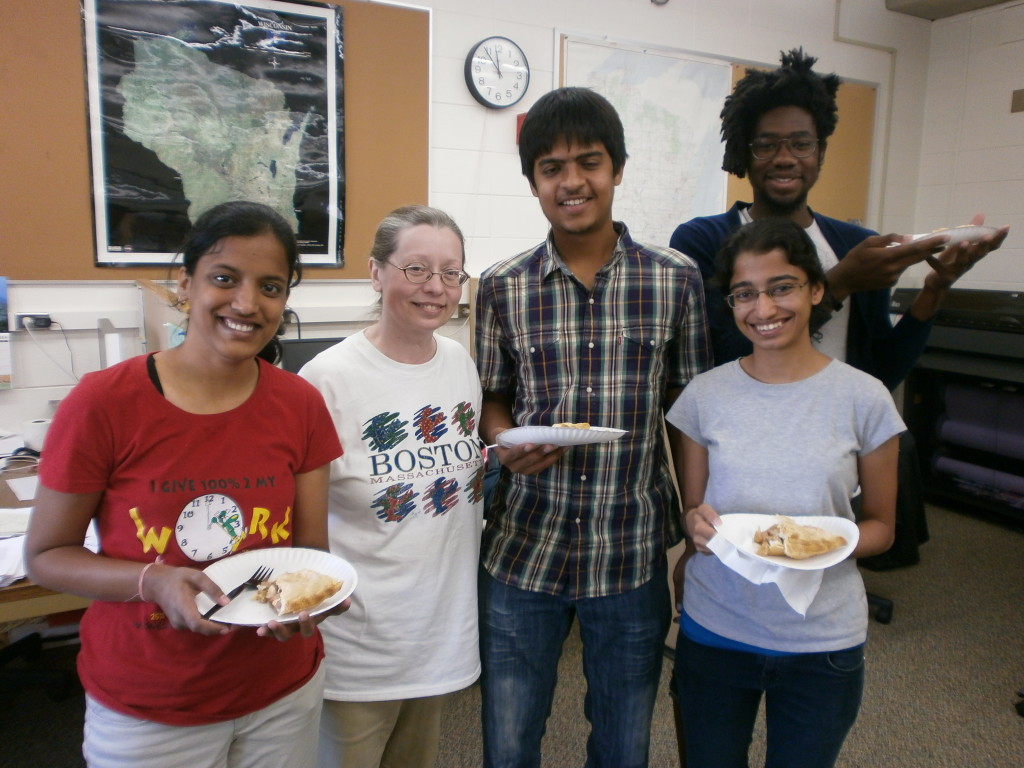S.N Bose Scholars Program brings students, talent to SSEC from India

SSEC scientist and mentor Sanjay Limaye sits with the four university students from India conducting research at UW-Madison this summer through the S.N. Bose Scholars Program, in its second year.
Students studying with the S.N. Bose Scholars Program said goodbye to Madison last month, some returning to India to complete their studies and others seeking work in their respective fields.
The S.N. Bose Scholars Program aims to bring promising physical science and engineering students to the United States from top universities in India. For the second year in a row, the University of Wisconsin-Madison partnered with the Government of India (DST), the Indo-U.S. Science and Technology Forum (IUSSTF), and the Science and Engineering Board of India for the scholarship exchange program.
This year, 45 students were accepted and matched with a professor in the U.S. based on their research interests. Nine were placed at UW-Madison, four of whom studied at the Space Science and Engineering Center (SSEC).

Four students were selected to study with Sanjay Limaye through the S.N. Bose Scholars Program, out of nine students placed at UW-Madison. The students pose with Limaye (far left) on the AOSS building roof.
To apply, each student was required to submit a CV, statement of purpose, and academic history. The scholarship would then cover airfare and a variety of living costs, while SSEC would fund its students’ housing. Each student placed at SSEC was interviewed and hand-selected by SSEC scientist Sanjay Limaye, who played an integral role in bringing the program to UW-Madison.
“Planetary atmospheric science is of interest to me, so I could most effectively mentor students matching those skills and interests,” Limaye said.
Arkopal Dutt, who studies aerospace engineering and theoretical physics at his university back home in India, said he developed a strong interest in atmospheric physics and thermodynamics through his studies this summer. Dutt’s work at SSEC involved calculating the adiabatic lapse rate in the atmosphere of Venus.
“In the first one-to-two weeks, we met with Sanjay [Limaye] to determine our interests,” he said. “Together, we found that I would not be designing a glider, but that I would be more interested in studying the atmosphere.”
Dutt said he was also glad for the opportunity to converse with SSEC Director Hank Revercomb, who conducted research in this area for many years.
Other SSEC researchers, including Rose Pertzborn, Tommy Jasmin, and Bob Krauss, acted as mentors for the students. Bose scholar Neha Joshi, an engineering student, said she enjoyed working with the mentors at SSEC, calling them “motivating” and “approachable.” Joshi used imaging technology to study clouds in the atmosphere of Venus, an area she may continue to study in India.

Bose scholar Arkopal Dutt with SSEC Director Hank Revercomb and SSEC scientist and Bose mentor Tommy Jasmin. Photo Credit: Neha Joshi.
“Our mentors are very encouraging,” added Bose scholar Prachi Bedekar, who was working to incorporate new features in an interactive applet with nearly a decade’s worth of planetary data — the largest amount of data she has ever worked with, she said. “They have been very helpful; I have learned a lot. Tommy [Jasmin] made it clear that if we work diligently he will do anything he can to help us.”
Limaye said the major criteria for selection into the program are students’ ability to work independently and be self-motivated. This year’s students agreed that they most appreciated the freedom to work independently, proceeding at their own pace to solve research problems of interest to them.
They also found the opportunity to conduct research in a real-world environment to be an invaluable experience. Joshi said she would undoubtedly recommend the program to other students, and seek out other opportunities like it in the future.
“The program gave me the environment to do proper research. It gave me the chance to apply what I’ve learned to a real, live project, and I got a glimpse of what grad school might be like,” Joshi said, adding that she hopes to apply to UW-Madison, among other universities. “The path to what I would like to do is a bit clearer.”
“We learned how to approach a problem and work at it … that there can be more than one way to solve a problem,” she continued, saying that simply being exposed to new and different topics of study can be beneficial.
Interdepartmental presentations attended by the students every other Saturday were one way to reinforce their learning.
“We like to focus on finding solutions, and applications, versus finding excuses,” said Pertzborn, who organized many of the events during the students’ stay in addition to one-on-one mentoring. “I think they were able to come away with a new perspective on how research is conducted.”

From left to right, Bose scholar Prachi Bedekar, SSEC scientist and mentor Rose Pertzborn, Bose scholar Mihir Kulkarni, Bose scholar Neha Joshi, and 12th floor researcher Eric Smith.
One student, Mihir Kulkarni, worked on writing image files from NASA missions into a format that could be read by weather analysis software for studying Venus. Kulkarni kept a blog to document his first impressions of Madison and his experiences with the program.
“The internship has introduced me to some wonderful people,” he wrote of his peers and mentors this summer.
“The people and various field trips made the experience wonderful,” echoed Bedekar, citing a visit to Yerkes Observatory in Williams Bay, Wisconsin, to see the world’s largest refracting telescope.
“I think this experience will help me a lot in my future projects,” continued Bedekar, who, now that the program is over, returns to India seeking a job related to computers and GPU processing.
The S.N Bose Scholars Program was modeled after the Khorana Program for Scholars, a scholarship program for biology students named after the University of Wisconsin-Madison’s first Nobel Prize winner, acclaimed biochemist Har Gobind Khorana. Like the Khorana program, it is meant to encourage scientific innovation by exposing India’s brightest undergraduate and graduate students to hands-on research in the U.S. Likewise, students from the U.S. may also apply to study in India.
For more information about the S.N. Bose Scholars Program, go to: http://go.wisc.edu/580o16.
